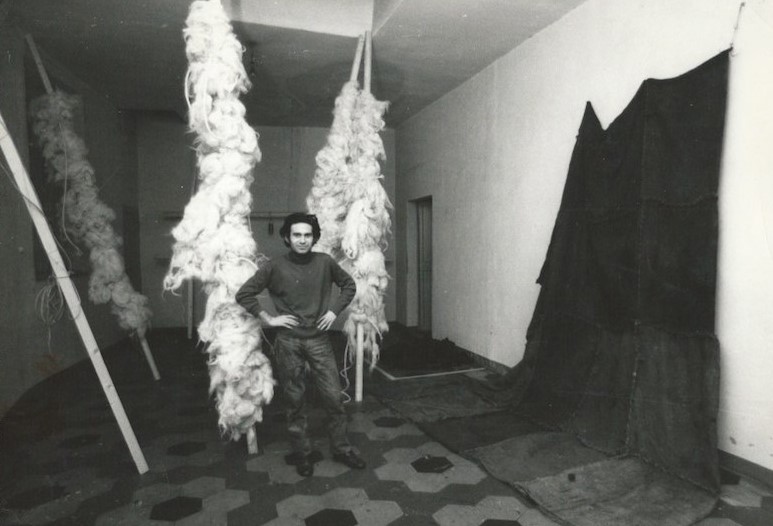Greek contemporary artist Jannis Kounellis lived and worked in a time of radical change on multiple fronts. He knew horse-drawn carts as well as sports cars, experienced the first days of radio, television, and the internet; lived through the rise and fall of fascism, and felt the excitement of the Space Race. Art too underwent transformative developments in his life time. Developments which, as a key figure in the Arte Povera (poor art) movement, he played a significant part in.
From Sea and Sailing to Stenciling and Stamping
Born in a sailing community in Piraeus, Greece, in 1936, Kounellis was raised surrounded by the industrial and raw materials associated with sea travel and trade. These objects would later make their way into his work, but let’s not jump ahead. Before Kounellis started constructing his fascinating installations, he was primarily a canvas artist.
At the age of twenty, he moved to Rome to begin his artistic career. Inspired by Italian Neorealist cinema and abstract expressionist art, especially Jackson Pollock, he began creating a cycle of paintings known as “Figures and Letters”, “Alfabeti” or simply the “Alphabet Paintings”. The paintings were comprised of numbers, words, letters and symbols printed on canvas using a cardboard stencil the artist had prepared. The fact that the signs were printed and not painted on the canvas was an important one to Kounellis, who sought to emphasize the structural and not the calligraphic in his work.

He began each piece by stretching large sheets of canvas or burlap over the interior walls of his home, so that even the platform on which he created was dictated by structure, in this case the architectural measurements of his dwelling. Fascinated by the concept of action painting, Kounellis saw the painting/printing process as an inherent part of his art and made it into a performance piece. He sang rhythmically while painting, draped in a canvas he had previously completed. The performance was documented by photographer Claudio Abate in an image that was reminiscent of the cone-like costume Dada artist Hugo Ball wore at the Cabaret Voltaire in Zurich, 1916.
Kounellis’ Alphabet Paintings were very well received in the artworld. First exhibited in 1960, the collection grew over the next couple of years as did the artist’s recognition. It was this acclaim that brought the project to its end, when Kounellis noticed the Alfabeti works were becoming a style, he stopped making them.
Art That Liberates Viewers from Ideological Constructs and Cultural Conditioning
The end of the Alphabet project led Kounellis into a deep artistic crisis. By 1963 he had almost completely stopped painting. Instead, he began bringing readymade and found elements that were reminiscent of his youth in Greece into his works. He later plunged even deeper into three-dimensional art and began experimenting with installations formed out of basic materials like steel, coal, wool and burlap. In 1967 these works were presented in the first Arte Povera exhibition, at the La Bertesca Gallery in Genoa. The exhibition displayed a collection of contemporary works concerned with the space between high-culture and everyday life, past and present, mythic and common, by using lowly materials to create high art. Kounellis went on to become a central contributor to the Arte Povera movement, exhibiting in several of its shows across Europe.
Bringing Life into Art
Throughout his career Kounellis sought to challenge and liberate the viewer by breaking down the barriers between art and life. He took this mission a step further in 1967 when he installed live birds in cages alongside his painting. By introducing life into his art, he turned the gallery into a stage of sorts and allowed his viewers to become part of the scene. In 1969, he brought 12 horses into the gallery space, and arranged them like cars parked in a garage. The exhibition was open for three days, during which the horses were tended to by professionals, and taken into comfortable stables every night. Although this work has been presented very few times and is mostly known through a grainy black and white photograph, it is still widely regarded as a Kounellis’ masterpiece.

Kounellis’ art consists of many courageous installations and sculptures that have paved the way for many groundbreaking artists who followed in his footsteps. Nevertheless, he always saw himself primarily as a painter. Even his installations were conceived pictorially. He thought in shape, color and canvas bringing the materials of his personal life and cultural history into the gallery like a painter applying brushstrokes to canvas.
Some may be tempted to define him as a conceptual artist, but he would vehemently disagree. In his own words: “I don’t know if I’m making myself clear, but if I were to accept this business of conceptual art, I would have no reason to exist.”